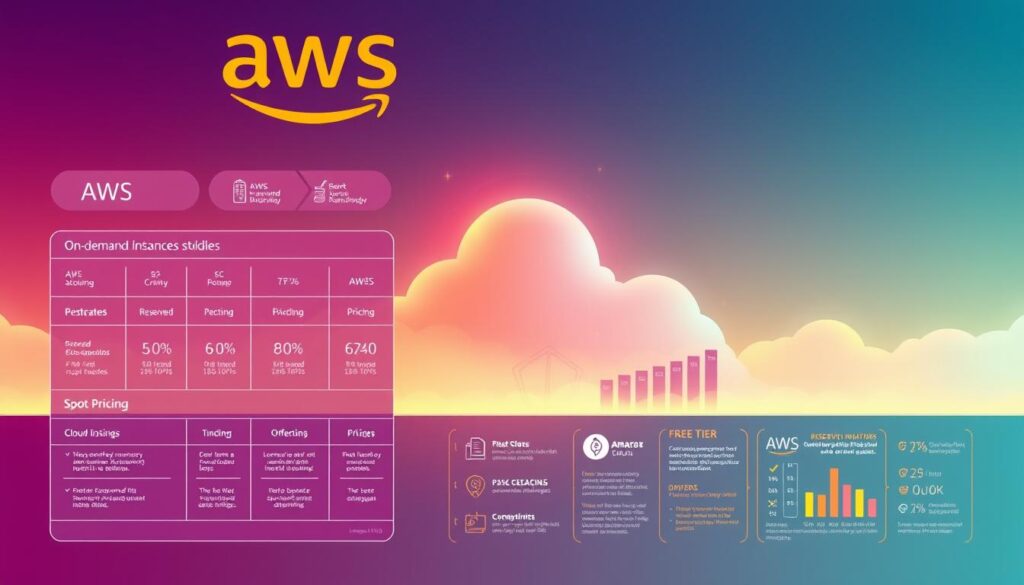Unlock the Power of Amazon Web AWS

Amazon Web Services is a leading cloud platform that delivers on-demand resources, APIs, and tooling to help teams innovate faster and cut capital costs.
The platform began key services in 2006 and now spans global regions and availability zones to support resilient, low-latency infrastructure. It offers core offerings like EC2 for virtual machines, S3 for object storage, and Lambda for serverless applications.
Cloud computing strategies rely on elastic scale and managed services to simplify operations and speed time to market. Pay-as-you-go pricing and a broad portfolio let teams start small, iterate quickly, and optimize as usage grows.
This Ultimate Guide previews compute, serverless, storage, databases, networking, identity, security, monitoring, migration, analytics, AI/ML, DevOps, pricing, and best practices. It is aimed at technical leaders and architects who need clear, structured knowledge to make informed decisions about data, applications, and infrastructure.
What Is Amazon Web Services and Why It Matters in Cloud Computing
Amazon Web Services is a comprehensive cloud platform that bundles IaaS, PaaS, and SaaS building blocks for teams of all sizes. It began with developer-focused web services and grew into a catalog of more than 200 services used across 245 countries and territories.
From 2006 launch to a global leader in cloud infrastructure
In 2006, S3 and EC2 launched on-demand infrastructure that changed how teams provisioned compute and storage. That milestone drove rapid adoption for diverse workloads, from web applications to analytics and AI.
How pay-as-you-go transformed IT budgets and agility
Pay-as-you-go moved costs from large capital purchases to flexible operating expenses. Teams can experiment faster, scale predictably, and shift focus from hardware to innovation.
- Global availability: multiple regions and availability zones for reliability and compliance.
- API-first control: SDKs and consoles enable automation and integration.
- Managed services: reduce undifferentiated heavy lifting for databases, messaging, and security.
| Capability | Impact | Typical Use |
|---|---|---|
| IaaS / PaaS | On-demand compute and storage | Virtual servers, containers |
| Managed services | Less operational overhead | Databases, messaging, monitoring |
| Global regions | Low latency and compliance | Enterprise and regulated workloads |
Understanding the AWS Global Network: Regions, Availability Zones, and Data Centers
A resilient cloud strategy starts with understanding how regions and availability zones separate faults and localize risk.
As of March 2024, the platform operates in 33 regions, each made of multiple Availability Zones (AZs). Each AZ is built from separate data centers with redundant power and networking to reduce single-point failures.
Regions, AZs, and low-latency design for high availability
Regions are geographic boundaries; AZs are isolated locations within them. Multi-AZ deployments improve fault tolerance for critical workloads by isolating hardware and network faults.
Data residency, redundancy, and opt-in regions
Regions launched after March 20, 2019 require explicit opt-in. IAM resources propagate only to regions that are enabled, which affects governance and identity planning.
- Select regions for compliance, proximity to users, latency, and available services.
- Regions usually sit inside a single country to support data residency and sovereignty needs.
- Low-latency links between AZs enable active-active deployments and zone-aware services.
- Cross-region replication adds resilience but introduces cost and consistency tradeoffs.
- Edge services and global accelerators can reduce latency at the network perimeter.
Testing and monitoring are essential. Regular failover drills validate multi-AZ and multi-region designs and improve operational security and recovery confidence.
Core Compute on AWS: Amazon EC2, Auto Scaling, and Virtual Servers
Compute choices determine performance, cost, and recovery for most cloud applications today.
Amazon EC2 provides virtual servers in many families optimized for compute, memory, storage, and accelerated workloads. General purpose instances suit web tiers and small databases. Compute-optimized work best for high-CPU batch jobs. Memory-optimized supports in-memory caches and databases. Storage-optimized and GPU/accelerated types target heavy I/O and ML inference.
Load balancing and scaling patterns
Elastic Load Balancing distributes traffic across healthy targets. Choose an Application Load Balancer for HTTP/S routing and host-based rules. Use a Network Load Balancer for extreme performance and TCP workloads.
Auto Scaling adjusts capacity automatically. Target tracking keeps metrics near an SLA. Predictive scaling reduces cold-start risk for predictable peaks. These strategies cut cost while preserving performance.
Tenancy, storage, and operational best practices
Customers pick shared tenancy for cost efficiency or dedicated hosts for isolation, BYOL licensing, and noisy-neighbor mitigation. EC2 integrates with EBS for persistent block storage; ephemeral instance disks trade persistence for local I/O speed.
- Right-size instances via workload profiling and performance tests.
- Mix pricing (on-demand, reserved, savings plans, spot) to balance steady-state and bursty demand.
- Monitor compute with CloudWatch metrics, logs, and alarms for SLOs.
- Adopt immutable infrastructure with blue/green or canary deployments to reduce update risk.
Serverless and Event-Driven Compute with AWS Lambda
Serverless execution lets teams run code without handling servers or capacity planning. It is a fully managed service that scales functions automatically and bills by requests and compute duration.
Lambda can be the better choice over EC2 for spiky or intermittent workloads. It suits event processing, microservices, and short-lived APIs. Developers deploy via console, CLI, SDKs, or frameworks like AWS SAM.
“Run code in response to events from dozens of services and SaaS tools, and pay only for actual usage.”
- Triggers: API Gateway, S3 events, Kinesis, DynamoDB streams enable event-driven flows.
- Config: Set memory, timeout, and provisioned concurrency to control performance and cold starts.
- Security: Use least-privilege IAM roles, encrypt environment variables, and enable VPC access when needed.
- Observability: Structured logs and tracing with CloudWatch and X-Ray help trace invocations and data paths.
- CI/CD: Package and version functions with SAM or similar frameworks; use aliases for safe rollouts.
- Patterns: Fan-out, queue buffering, and dead-letter queues improve throughput and resilience.
| Aspect | Lambda | EC2 |
|---|---|---|
| Best fit | Event-driven, bursty apps | Long-running, stateful services |
| Pricing model | Per request and duration | Instance-hour pricing |
| Management | Fully managed | Customer manages OS and scaling |
Storage Services: Simple Storage Service (S3), Elastic Block Store (EBS), and EFS
Object, block, and file storage each solve different problems for data access and lifecycle needs.
Simple storage service offers scalable object storage with classes such as Standard, Infrequent Access, and archival tiers like Glacier and Glacier Deep Archive.
Use lifecycle policies to tier objects automatically, enable versioning for protection, and apply bucket policies and encryption for data security.
Block store performance for compute
Elastic block store delivers block-level volumes attached to instances. Choose gp for general use, io for high IOPS, and st for throughput-heavy tasks.
Tune snapshots and monitor IOPS and throughput in CloudWatch to match workload SLAs.
Shared file storage and hybrid patterns
Amazon elastic file storage (EFS) provides POSIX-compliant, scalable shared access for containers and web content repositories.
Hybrid patterns use Storage Gateway for local caching and S3-backed archives, while Snow devices help migrate large data sets.
“Pick object storage for archives and media, block storage for attached compute, and file storage for shared POSIX access.”
| Storage Type | Best Fit | Key Considerations |
|---|---|---|
| Simple storage service (S3) | Archives, static assets, data lakes | Classes, lifecycle, multipart uploads, cost tiering |
| Elastic block store (EBS) | Boot volumes, databases, low-latency I/O | IOPS, gp/io/st types, snapshots, encryption |
| Elastic File System (EFS) | Shared POSIX file systems, containers | Throughput mode, NFSv4, performance scaling |
Databases on AWS: Relational, NoSQL, and Data Warehousing
Databases form the backbone of most modern applications. Choosing the right managed service shapes performance, cost, and operational load. This section outlines options for transactional workloads, low-latency key-value access, document and graph models, and large-scale analytics.
Amazon RDS and Aurora for transactional workloads
Amazon RDS manages engines like MySQL, PostgreSQL, Oracle, SQL Server, and MariaDB with automated backups, patching, and read replicas. Amazon Aurora offers higher throughput for demanding OLTP and simplifies scaling for many production apps.
NoSQL: key-value, document, and graph
DynamoDB is a managed NoSQL key-value store for single-digit millisecond reads and global tables. DocumentDB fits document models compatible with MongoDB. Neptune supports graph queries and relationship-heavy workloads.
Analytics at scale with Redshift
Redshift uses columnar storage and an MPP architecture to run BI and analytics on large datasets. RA3 nodes separate storage from compute to optimize cost and performance for petabyte-scale queries.
- Use ElastiCache or DAX to cache hot reads and speed response times.
- Apply multi-AZ and snapshots for HA/DR; use reserved instances or RA3 sizing to control costs.
- Secure databases with encryption, IAM auth where supported, and VPC subnet isolation.
“Pick the model that matches your data and query patterns to reduce cost and complexity.”
Networking and Edge: Amazon VPC, Route 53, and Load Balancers
Properly built virtual networks let teams control IP space, routing, and service access for every workload.
Virtual private clouds provide isolated network boundaries with CIDR selection, public and private subnets, route tables, internet gateways, NAT gateways, and VPC endpoints. These elements form the foundation for scalable infrastructure and secure access to managed services.
Designing secure subnets, routing, and NAT
Place outward-facing tiers in public subnets and back-end systems in private subnets. Use NAT gateways for outbound internet, route tables for traffic control, and endpoints to keep service traffic inside the cloud.
Application and network load balancer patterns
amazon elastic load balancing offers two patterns: ALB for layer-7 host and path routing, and NLB for ultra-low latency, static IPs, and TLS pass-through. Choose the load balancer that matches application needs.
Private connectivity with Direct Connect
Direct Connect provides dedicated links from data centers for consistent bandwidth and lower egress variability versus the public internet. Hybrid architectures often combine Direct Connect with transit gateways for hub-and-spoke segmentation.
- Use security groups, network ACLs, and endpoint policies to enforce least privilege and network-level security.
- Route 53 routing policies—simple, weighted, latency, failover—and health checks support global resiliency.
- Enable VPC flow logs and DNS logging to monitor traffic, detect anomalies, and optimize routing.
“Design networks to separate trust zones, reduce blast radius, and make recovery predictable.”
Identity and Access: IAM and Organization-wide Governance
Centralizing identity makes it easier to apply consistent guardrails across many environments and teams.
Identity access management controls who and what can call services and access data. It uses users, roles, and policies to grant least-privilege access to applications and service accounts.
Identity and role best practices
Prefer short-lived role assumption instead of long-lived keys. Require MFA for interactive access and for sensitive operations.
Use permission boundaries and role separation to limit blast radius. Group privileges by job function, not by person.
“Design roles so that a single compromised credential never grants broad control across all accounts and services.”
Accounts strategy and governance
AWS Organizations helps centralize billing and apply service control policies across multiple aws accounts. Separate environments by workload sensitivity or business unit to simplify audits.
- Use organizational OUs to apply guardrails and service restrictions.
- Enable regions deliberately; IAM resources propagate only to enabled regions in opt-in areas.
- Federate identities to an existing provider and enforce SSO for consistent access management.
| Topic | Recommended Practice | Benefit |
|---|---|---|
| Users / Roles | Role assumption, MFA | Reduces long-lived credentials risk |
| Accounts | Environment separation | Limits blast radius, simplifies audits |
| Governance | Service control policies, centralized logging | Consistent guardrails and compliance evidence |
Track and audit changes with CloudTrail and Config. Logs and configuration history make security reviews and incident response faster.
Security on AWS: Shared Responsibility, Threat Detection, and Protection
Effective security starts with clear ownership. The provider secures physical infrastructure and facilities. The customer secures accounts, identities, configurations, and their data in the cloud.
Continuous assurance uses managed tools to find and classify risks. Amazon Inspector scans for vulnerabilities. Macie discovers and labels sensitive data. Detective helps trace incidents to root causes.
Layered defense for network attacks
Shield offers DDoS protection at the edge, while WAF filters malicious HTTP requests. Combining both reduces exposure to common internet threats.
Encryption, keys, and compliance
Encrypt data at rest and in transit. Use a key management service with rotation and least-privilege access. Access compliance artifacts on demand to support audits and reporting.
Operational practices include centralized logging, SIEM integration, and automated remediation to speed response. Apply threat modeling, secure defaults, and periodic validation with configuration rules to keep controls effective.
“Security is a continuous process: detect, protect, and validate.”
Management and Monitoring: CloudWatch, CloudTrail, and Config
Monitoring, auditing, and configuration tracking form the backbone of reliable cloud operations. Teams use these capabilities to spot issues early, prove compliance, and speed recovery. The right mix of telemetry and automation turns alerts into predictable outcomes.
Operational visibility and auditing across accounts
Observability starts with collecting metrics, logs, and traces from resources and applications. CloudWatch provides metrics, logs, alarms, and dashboards to track performance and availability.
CloudWatch alarms and dashboards help detect anomalies and capacity problems before users notice. Dashboards group key metrics for SLO-driven teams to review at a glance.
CloudTrail records API activity and builds timelines for auditing and forensic investigation. Centralizing audit logs across accounts and regions makes root-cause analysis faster and more reliable.
AWS Config tracks resource configuration and flags drift from desired state. Use Config rules to evaluate compliance and trigger automated remediation when policies fail.
- Centralize logs and metrics from all accounts to get comprehensive visibility.
- Use Systems Manager runbooks and automation for patching, configuration, and secure remote tasks.
- Run Trusted Advisor checks to find cost, fault-tolerance, and security improvements.
- Define SLOs and SLIs, and tie alerts to measurable reliability goals.
“Collect telemetry, audit API calls, and enforce configuration as code to keep operations predictable.”
Migration and Hybrid Cloud: Using AWS Migration Hub, DMS, and Outposts
Moving production systems requires tools that centralize progress and reduce guesswork. Using AWS Migration Hub gives teams a single view of migration status across tools and phases.
Plan first: run discovery, map dependencies, and group applications into prioritized migration waves. Define acceptance tests and rollback criteria before any cutover.
Database moves and cutover patterns
AWS Database Migration Service simplifies heterogeneous and homogeneous database moves. DMS also supports change data capture for near-zero downtime replication.
Best practice: run full load, validate rows, then use CDC to sync changes before switching writes to the target.
Hybrid connectivity and local processing
Outposts provides consistent APIs and toolchains for on-premises processing, while Storage Gateway offers cached and stored volumes tied to S3.
For network links, combine Direct Connect with VPN for secure, predictable performance and failover.
- Choose rehost, replatform, or refactor based on risk and cost.
- Benchmark target infrastructure and run cutover rehearsals.
- Document rollback steps and monitor replication lag during transition.
| Strategy | When to use | Key benefit |
|---|---|---|
| Rehost | Lift-and-shift | Fast migration |
| Replatform | Minor changes | Optimize cost |
| Refactor | Modernize apps | Long-term agility |
“Centralize visibility, test thoroughly, and automate cutover where possible.”
Analytics and Big Data: EMR, Kinesis, Glue, Athena, and QuickSight
Modern analytics stacks combine batch and stream tools to turn raw logs into timely insights. Teams build data lakes on S3 with schema-on-read and partitioning to cut cost and speed queries.
Streaming data pipelines with Kinesis
Kinesis ingests high-volume streams and routes records to processors for real-time analytics and alerting. It supports windowing, aggregation, and fan-out patterns for low-latency metrics.
Data lake querying with Athena on S3
Athena provides serverless SQL over object storage. Best practices include partition pruning, compacted file formats, and careful table design to reduce scan costs and speed results.
ETL orchestration using Glue
Glue crawlers build a centralized data catalog. Jobs handle transforms and scheduling so downstream dashboards and ML pipelines get clean, discoverable datasets.
- EMR runs Spark, Hive, and Presto for large transformations and feature engineering.
- QuickSight delivers interactive dashboards, embedded analytics, and ML-driven insights.
- OpenSearch Service supports log analytics and observability at scale.
“Governance, encryption, and access controls are essential to protect sensitive datasets end-to-end.”
AI and Machine Learning: SageMaker, Amazon Bedrock, and Emerging Models
Foundational models and end-to-end tooling shorten the path from idea to deployed models in enterprise environments.
Amazon SageMaker is a fully managed service for building, training, and deploying models. It covers data preparation, training jobs, hyperparameter tuning, inference endpoints, and MLOps pipelines.
Building, training, and deploying
SageMaker helps teams prepare data, run distributed training, and tune models at scale. It offers managed notebooks, training clusters, and inference autoscaling to support production workloads.
Foundation models via Bedrock and Nova
Bedrock exposes foundation models through a unified API so teams can integrate powerful models without managing infrastructure. In December 2024 the provider introduced Nova, a family of foundation models for content generation, video understanding, and agentic applications.
- Governance: track data lineage, run bias detection, and enforce secure deployments.
- Cost control: right-size instances, use spot or managed endpoints, and autoscale inference to limit spend.
- Integration: connect models to analytics, feature stores, and application services to operationalize predictions.
“Treat model lifecycle as part of the engineering workflow: instrument, test, and monitor continuously.”
Developer Tools and DevOps: CodeCommit, CodeBuild, CodeDeploy, and Pipelines
A reliable CI/CD pipeline turns commits into tested releases with minimal manual steps.
End-to-end developer toolchains include source control, build systems, deployment automation, and tracing to keep releases safe and repeatable.
CI/CD and infrastructure as code
CodePipeline orchestrates CodeCommit, CodeBuild, and CodeDeploy to automate release flows. Pipelines run tests, scans, and approvals before producing artifacts.
CloudFormation expresses infrastructure as code through templates, change sets, and stack policies. This reduces drift and speeds repeatable deployments.
- Productivity: Cloud9 and SAM support faster iteration and local testing for serverless applications.
- Risk reduction: Blue/green, canary, and feature-flag strategies limit impact during rollouts.
- Quality gates: Automated tests, security scans, and policy checks enforce continuous compliance.
- Observability: X-Ray and CloudWatch provide traces and metrics to troubleshoot distributed systems.
| Tool | Role | Benefit |
|---|---|---|
| CodeCommit | Source control | Managed git hosting |
| CodeBuild | CI builds | Scalable build environments |
| CodeDeploy | Automated deploys | Blue/green and in-place options |
| CloudFormation | IaC | Repeatable infra and change sets |
“Automate builds, tests, and deploys so teams can deliver features with confidence.”
amazon web aws Pricing, Free Tier, and Cost Optimization Strategies
Controlling cloud costs starts with understanding billing models and choosing the right purchase options. The platform bills per-second or per-hour depending on the service, so design decisions directly affect monthly spend.

Pay-as-you-go, reserved options, and the AWS Pricing Calculator
On-demand pricing gives flexibility for variable loads. For steady-state compute, consider Reserved Instances or Savings Plans for one- or three-year terms to capture discounts.
- Free Tier: uses “always free,” 12-month, and trial offers across about 60 products to test ideas and build proofs-of-concept.
- Visibility: tagging, cost allocation reports, and Budgets enable alerts and granular chargeback.
- Optimization: right-size instances, schedule non-production shutdowns, and use Spot where risk permits.
- Storage & data: apply lifecycle policies, tier data, and minimize cross-region egress to lower transfer fees.
- Design tool: use the Pricing Calculator to compare architectures and forecast budgets before procurement.
| Option | Best fit | Benefit |
|---|---|---|
| On-demand | Unpredictable load | Flexibility |
| Reserved / Savings | Stable usage | Lower hourly cost |
| Spot | Fault-tolerant jobs | Lowest compute price |
“Track usage, model costs early, and automate controls to turn visibility into savings.”
Maximizing Value from the AWS Cloud Today
Maximizing cloud value starts with clear goals, repeatable guardrails, and a plan that ties architecture to measurable outcomes.
Teams should map workloads to the right compute and storage choices — EC2, containers, serverless, EBS, and simple storage service classes — to balance cost and performance. The provider’s global network and data centers enable resilient multi-AZ and multi-region designs for critical applications.
Adopt identity access management, multi-account isolation, and automated runbooks to reduce risk. Combine managed databases, analytics, and ML services like RDS/Aurora, Redshift, SageMaker, and Bedrock to speed delivery without heavy upkeep.
Finally, invest in observability, FinOps, and continuous security scanning. Regular architecture reviews, training, and partner support help teams sustain efficiency and unlock new capabilities from the cloud.



